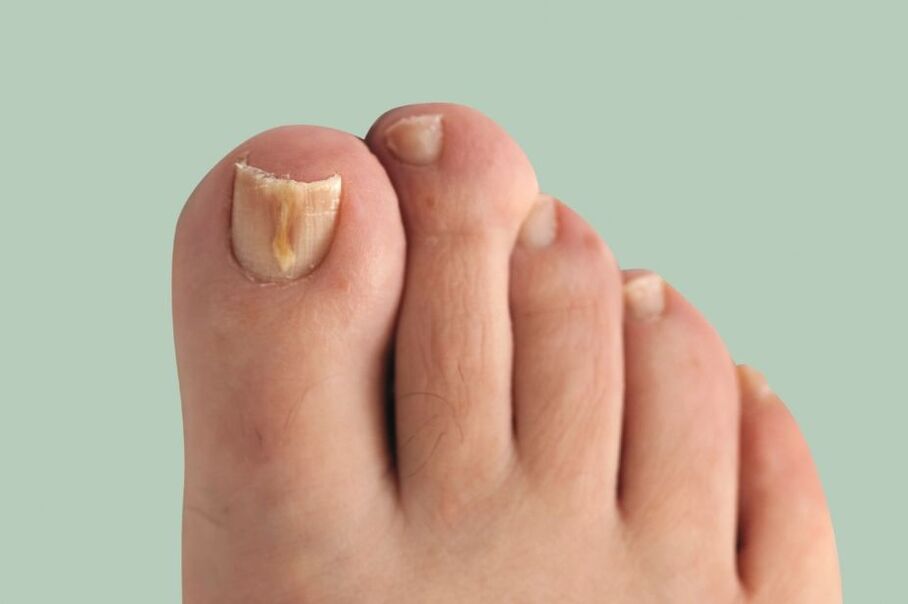
Nail fungus(onychomycosis) is a fungal infection of the nail plate and surrounding structures: nail folds, nail matrix (nail growth), and nail bed. It is manifested by deformation and thickening of the nail, changes in color - the nail becomes white or yellow.
This disease is quite common. According to some data, the incidence of onychomycosis in Europeans reaches 10-12%, which exceeds the known indicators of the last decade. It occurs 1. 5 times more often in men, but they visit the doctor 2 times less than women. Older people are more likely to get sick, and children are very rare.
The main problem in treating the disease is that the patient has to see a dermatologist a long time after the first symptoms appear. Because of this, the pathological fungus covers a large area and treatment is delayed.
Pathogenic fungi can only be transmitted by sick people. Very often, fungal infections occur in the family due to not identifying the source in time and not taking appropriate preventive measures.
The cause to the illness:most often in direct contact with the patient or with objects used by the patient (shoes, clothing, bath mats, towels, nail accessories). Infections often occur when visiting gyms, baths, saunas, and swimming pools.
The development of the disease is facilitated by microscopic lesions - cracks in the interdigital folds that occur due to abrasion, excessive sweating, dry skin, poor dryness after proceduresAquatics and flat feet.
Onychomycosis can also occur when there are concomitant diseases of the endocrine system (diabetes mellitus, obesity, hypothyroidism), vascular diseases of the extremities (venous insufficiency, lymphostasis), immune disorders, as well as the use of antibiotics, corticosteroids and cytostatics. Due to the above diseases, blood microcirculation in the nail area is disrupted and natural immunity is reduced, which contributes to the development of secondary infections.
Onychomycosis is caused by the following fungi:
- dermatological cells;
- yeast of the genus Candida;
- mold.
Depending on the type of pathogen, the penetration of the fungal infection and the clinical picture are different, so the treatment approach is also different.
Toenails are 10 times more affected by fungus than fingernails. In most cases, the fungus is caused by dermatophytes (eg, Trichophyton rubrum). The remaining cases are often caused by molds other than skin fungi (Aspergillus, Scopulariopsis, Fusarium).
If you notice similar symptoms, consult your doctor. Do not self-medicate - it is dangerous for your health!
Along with nail fungus, foot fungus can also develop. Athlete's foot (dermatophytosis, Tinea pedis) is a disease of the skin of the feet caused by pathogenic or opportunistic fungi. Skin changes on the feet are characterized by peeling, accompanied by itching. In cases of severe damage, on red and swollen skin, erosions and deep cracks appear on the soles of the feet and the spaces between the toes, accompanied by pain and making walking difficult. .
The emergence of modern antifungal drugs has improved the epidemiological situation, but mycosis of the feet remains one of the most important problems in dermatology. The use of some drugs is limited in the elderly and patients with chronic diseases.
Path of infection
The risk of fungal infection is especially high in public places with high humidity. These are saunas, swimming pools, gyms, public baths, etc. v. The most common routes of infection:
- direct contact with an infected person. Here the fungus moves from the living environment to a healthy area, thereby causing infection;
- family way. In this case, infection occurs when using the sick person's personal belongings: shoes, toiletries, etc. v.
Risk factors
The incidence of onychomycosis increases at the age of 60. At this time, the likelihood of developing such an infection is 60%, which is explained by the slowing down of metabolic processes, especially in thedistal (distant) parts of the body, which are the fingers and toes.
Other risk factors for developing nail fungus include:
- diabetes;
- varicose veins;
- injury to the nail and adjacent tissues;
- HIV and other immunodeficiency conditions;
- long-term use of antibiotics;
- weakened immune system;
- vascular and skin diseases, dermatitis, diaper rash;
- disorders of blood supply to the limbs;
- not hygienic enough.
Symptoms of onychomycosis (nail fungus)
The longer the disease lasts, the more obvious the symptoms become. The main signs of onychomycosis include:
- dyschromia - change in the color of the nail to yellow, black, green, gray or brown (the type of color depends on the type of fungus);
- Onychomycosis - separation of the nail plate from the bed;
- change the thickness of the nail plate;
- hapalonychia - reduces the thickness of the sheet and softens it;
- koilonychia - the nail looks concave, has a teaspoon shape;
- pachyonychia - thickening of the nail plate, nail hypertrophy;
- Onychomycosis - nail plate thickening, discoloration, beak-shaped curvature;
- change in the thickness of the nail bed (hyperkeratosis - thickening of the nail bed);
- changes on the surface of the nail plate: pits, grooves, ridges;
- changes in the nail folds and surrounding skin (paronychia - inflammation of the proximal nail fold).
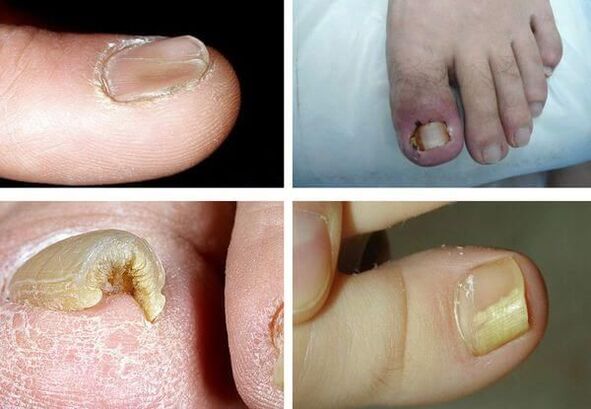
It is important to note that none of the symptoms is pathology-specific, i. e. uniquely consistent with a particular pathogen, so it cannot be identified by symptoms - further examination is required.
Pathogenesis of onychomycosis (nail fungus)
The pathogenesis of the disease depends on how the fungus penetrates the skin and nails.
Distal subungual type:If the fungus has penetrated the skin in the nail fold or distal area, the infection will spread through the free edge of the nail bed and further to the base layer. At first, the nail plate may remain unchanged, but then due to hyperkeratosis, it gradually moves away from the nail bed and becomes yellowish. The nail plate may gradually thicken.
White surface type:If white lesions form on the surface of the nail, then over time the fungus will invade the entire nail plate. Nails thicken, crumble and turn gray-brown. In this case, the matrix and epithelium of the nail bed are not affected. There was no surrounding dermatitis.
Proximal subungual type:The fungus can spread from the skin and periungual folds to the nail plate and beyond to the base layer, to the distal parts of the nail plate. Spots appear on the nail in the area of the hole and nail bed, and peeling of the nail plate occurs. There was no significant inflammation of the nail bed or matrix.
Total type of dystrophy:The entire nail is affected. The proximal part of the nail fold disappears or thickens so that the nail plate can no longer form or grow.
existPhysiological concepts of the pathogenesis of onychomycosis, this indicates that during the course of the disease there is a confrontation between two forces: fungal colonies growing towards the matrix and the natural growth of the nail from the matrix to the distal edge. Therefore, the speed of nail growth is very important in the development of onychomycosis - the faster the nail grows, the sooner it can be treated. Perhaps this is the reason for the low incidence of the disease in children, because their nails grow faster than those of adults and the elderly.
Classification and stages of development of onychomycosis (nail fungus)
There is the following classification of onchomycosis:
- under the distal nail;
- white appearance;
- near under the nail;
- total dystrophy.
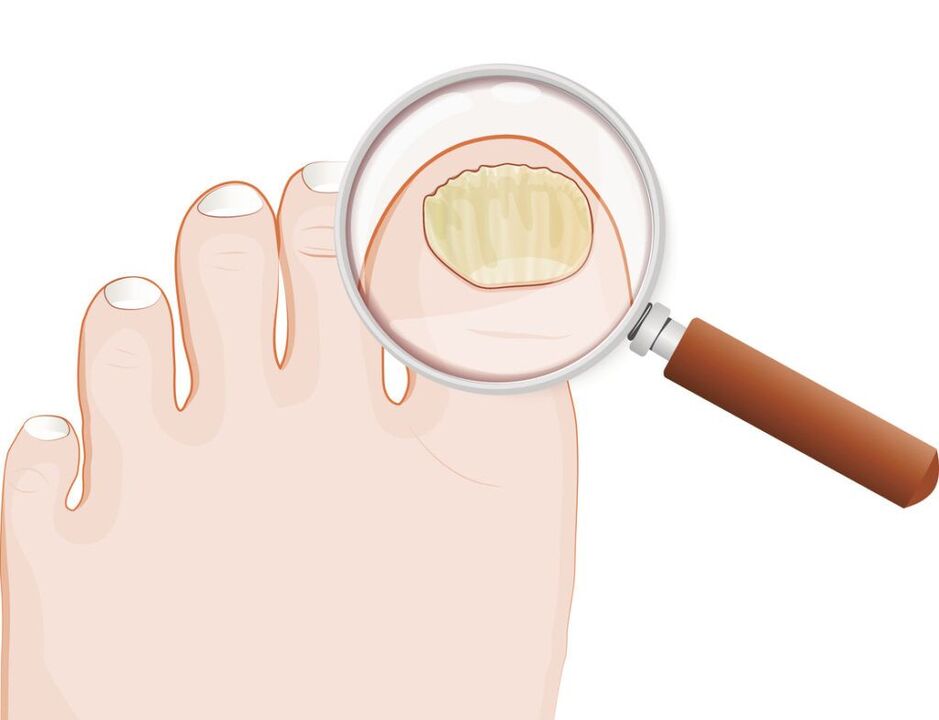
According to Arievich's classification (1970):
- normalize: in the thickness of the nail there are yellow and white stripes, but the shape of the nail plate does not change, there is no hyperkeratosis under the nail;
- hypertrophy:The nail plate turns yellow, thickens due to hyperkeratosis under the nail, becomes brittle, has jagged edges;
- dystrophy:Thinning and peeling of the nail plate from the nail bed occurs along with the formation of voids.
Complications of onychomycosis (nail fungus)
Long-term onychomycosis increases the risk of developing itdiabetic feet(formation of trophic ulcers on the legs) andgangreneif the patient has diabetes or vascular diseases of the lower limbs.
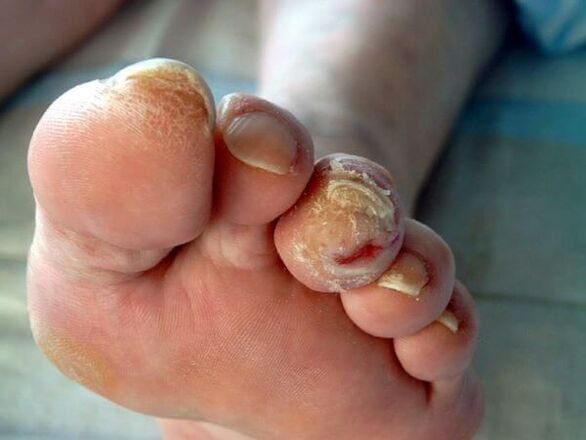
In immunosuppressed states (primary and secondary immunodeficiency), fungi can spread to the skin and internal organs and cause allergies in the body. This can manifest itself in the form of skin rashes and even the development of bronchial asthma.
In an uncomplicated process, the disease causes traditional symptoms for fungus, causing only severe discomfort in a person. But if left untreated, nail fungus can cause complications. Usually they manifest themselves with the addition of a bacterial infection.
Sometimes onychomycosis is very acute with the appearance of blisters, ulcers and oozing spots on the skin next to the nails. In severe cases, the disease takes on a generalized form. This means that the nail fungus spreads to organs and internal systems, after which the patient will need to be urgently hospitalized.
Diagnosis of onychomycosis (nail fungus)
Before considering the methods of diagnosing onychomycosis, it is necessary to explain how to correctly collect research material (the patient does this himself or prepares the nails before diagnosis). Before collecting research material, it is necessary to treat the nail plate with 70% alcohol to avoid other bacterial contamination.
The method of collecting material varies depending on the form of onychomycosis:
- surface form- scrape from the nail plate;
- distant form- it is necessary to shave both the nail bed and a piece of the nail plate;
- proximal subungual form- material is collected using a drill, or a nail biopsy is performed, or a scraping is performed from the nail bed.
The fastest method to identify pathological fungus in nails ismicroscope. Technique: the material under study is treated with an alkaline solution to dissolve the keratin. To make the mycelium more visible, ink is added to the lye. Next, the resulting preparation is studied under a microscope.
This research method is the fastest and most objective. Sensitivity up to 80%. The disadvantages of the method include the fact that when using it it is impossible to determine the type of pathogen.
Bacterial culture: is an additional method for diagnosing onychomycosis. The material is sown on a special medium and the results are interpreted under a microscope after 2-3 weeks. This method allows you to determine the type of pathogen - this helps determine treatment tactics and choice of drugs based on sensitivity. But the disadvantage of the research is that it takes a lot of time and the sensitivity is only 30-50%.
Biopsy: Using a scalpel and anesthesia, remove the nail and nail bed. The material is soaked in a formaldehyde solution and sent for histological examination in the laboratory. The advantage of this method is that it has high sensitivity and allows you to determine the presence of pathological fungi in the material.
Disadvantages: cannot identify pathogens nor determine the viability of microorganisms, this method is expensive and labor-intensive.
Genetic diagnosis: molecular biology research method (PCR). This is one of the new and highly sensitive methods to diagnose onychomycosis - helping to detect the DNA of the pathogen. In our country, this type of diagnosis is encouraged to be applied in medical facilities with PCR laboratories, but currently, the testing system for determining dermatological bacteria and molds is only planned to be put into laboratories. experience. This method allows you to determine the type of pathogen, and its sensitivity ranges from 80-90%. Disadvantages: high cost, difficult to access, lack of technology standards and complexity in implementation.
More and more doctors are putting it into practiceskin screening. Using this method, you can evaluate changes in the color and structure of the nail as well as the condition of the surrounding structures. Dermoscopic examination allows a more accurate assessment of the depth of damage to the nail plate and a more accurate calculation of the index of onychomycosis severity (KIOTOS).
First of all, the patient is sent for microscopic examination, which allows to determine the presence of pathogens. In the future, it is necessary to determine its type in order to choose the correct method of treating toenail fungus. At JSC "Medicine" (clinic of academician Roitberg) in the center of Moscow, the most modern and popular methods of diagnosing onychomycosis are carried out:
- Cultural examination of biological samples of affected tissue. To do this, it is placed in an artificial nutrient medium where the pathogen is grown to determine its type;
- Polymerase chain reaction (PCR) method for detecting pathogen DNA in affected tissue samples.
When to see a doctor
Many people who have encountered nail fungus know that this disease develops slowly and is extremely difficult to treat. That is why it is so important to consult a doctor when the first signs of the disease appear. A dermatologist treats nail fungus at our clinic in the center of Moscow. The specialist will provide competent support and will guide you until full recovery.
Prepare to see a doctor
Before visiting a dermatologist, it is important not to treat the affected areas of the nail with anything, ie. Do not use drugs, including iodine and brilliant green. It is also important to avoid using antifungal creams and ointments. At your appointment, you should have all the tests you had previously done, including tests for other diseases. Affected nails should not be cut for 3-4 days before consultation.
Treatment of onychomycosis (nail fungus)
There are several types of treatment for nail fungus:
- Local therapy.
- Systemic therapy.
- Combination therapy.
- Remedial therapy.
On-site treatmentinvolves applying medication to the nail plate and nail folds. Indications for topical treatment:
- Form that limits damage to the nail plate (according to KIOTOS).
- There are contraindications to the prescription of systemic drugs: hypersensitivity, liver disease, kidney dysfunction, pregnancy, breastfeeding.
The advantage of this therapy is that a high concentration of the therapeutic agent is formed on the surface of the nail, which does not penetrate into the blood. There are no side effects when using antifungal drugs - nausea, loss of appetite, abdominal pain. The disadvantage of the method is that the medicinal substance does not always reach the pathogen's habitat, especially if the fungus is located at the base or foundation. This in turn can lead to treatment failure. This type of treatment is very laborious, because before applying the medicine it is necessary to cut off the affected nail.
Methods of removing affected nails:
- Mechanical removal with a file, pliers or drill.
- Use keratolytic patches. Before applying keratolytic plaster, the skin around the nail is sealed with plaster, a plaster block (urea with salicylic acid) is applied on top and sealed with adhesive plaster. The plaster block is changed every 2-3 days. After each removal, the affected nail is removed mechanically.
- Surgery. This operation is very painful and traumatic, because when the nail plate is removed, the growth area can be damaged, leading to deformed nails growing back.
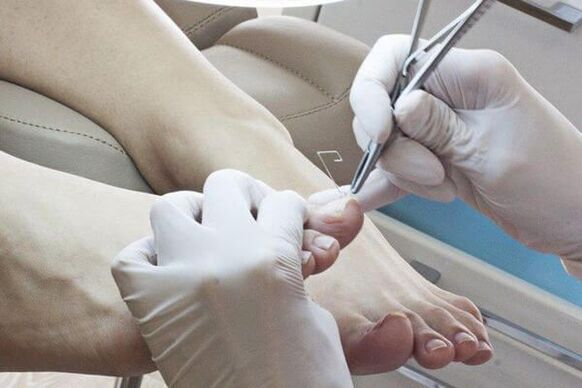
Local antifungal drugs are used after removing the affected nail plate.Antifungal medicationDifferentiated by place of application:
- Apply to nails: varnish;
- Apply to roller: cream, ointment, solution.
The most studied topical medication isNaftifine 1% solution, has an evidence base for treatment effectiveness based on a Cochrane meta-analysis. This product is water-based, allowing the antifungal agent to better penetrate the affected area. Varnishes, whose active ingredients are ciclopirox and amorolfine, have a dehydrating base, which reduces the penetration of the drug into the deep layers. Therefore, dermatologists consider the use of varnish unsatisfactory and increasingly favor water-based products.
To get results from local treatment, it is necessary to comply with the treatment regimen. It is important that the patient has a sense of responsibility, steadfastness and patience. Treatment time can be up to 12 months.
Systemic therapyallows the antifungal medication to enter the bloodstream to the site of injury, even if the nail bed and nail matrix are affected. High concentrations of the drug remain in the affected area for a long time after use stops. The disadvantages of this type of treatment are related to the risk of side effects and toxicity.
Indications for systemic treatment:
- Common types of nail plate damage.
- Lack of effect of topical therapy (i. e. , after six months of treatment for onychomycosis of the hands and 9-12 months of treatment of onychomycosis of the feet, healthy nails do not regrow).
To determine treatment tactics, KIOTOS (Clinical Index for assessing the severity of onychomycosis by Sergeev), edited by A. Yu. Sergeev proposed in 1999, used. It is used as a standard of treatment in many countries around the world.
Medicinefor the treatment of onychomycosis can be classified as follows:
- antifungal drug - has antifungal effect;
- antiseptic - has both antifungal and antibacterial effects. They are used rarely, only when no other antifungal agent is available;
- multi-component - in addition to antifungal agents, they also contain other drugs, such as anti-inflammatory drugs.
Prescription regimen:
- standard - take the drug daily for the prescribed treatment period;
- shortening - the duration of treatment is shortened, can be taken with regular or increased dosage;
- intermittent - treatment is prescribed in several short courses, the interval between courses is equal to the duration of the courses;
- Pulse therapy - treatment is prescribed in several short courses, the interval between courses is longer than the duration of the courses.
Antifungal drugs are divided according to active ingredients:
- triazole;
- allylamine;
- others (third generation drugs).
Currently used for systemic treatmentonly third generation drugs.
With combination therapyLocal and systemic treatments are performed simultaneously. Combination therapy is used when necessary to increase the effectiveness of systemic therapy and reduce treatment time.
Remedial therapy(treatment of accompanying diseases): to choose a treatment regimen, it is necessary to evaluate the general condition of the body. Diseases such as circulatory disorders in the extremities can reduce the ability of antifungal drugs to reach the lesion. Therefore, drugs are prescribed to improve the nutritional status of tissues.
Due to the toxic effects of systemic antifungals, liver disease should be excluded and, if necessary, hepatoprotective drugs should be prescribed.
home remedies
Before using home remedies, you should consult your doctor. With his permission, you can use the following formulas:
- iodine. Before use, the feet must be steamed, washed with laundry soap and then the affected areas of the nail plate must be removed. Next, treat the nails and skin between the fingers with iodine, soak them in a water bath with soda solution for 20-30 minutes and dry completely;
- Vinegar. For 3 liters of water take 1 tablespoon. apple cider vinegar and add a little potassium permanganate. Soak your feet in the bath for about 20-30 minutes, then dry thoroughly;
- hydrogen peroxide. After thoroughly steaming your feet, remove the affected areas on the nail plate. Place cotton pads soaked in hydrogen peroxide on them, wrap them with a bandage and leave for half an hour.
Dangerous myths and misconceptions about nail fungus treatment
One of the most important and dangerous myths is that nail fungus is not considered a serious disease. In fact, when onychomycosis progresses, it can lead to serious consequences, including deformation and complete removal of the nail from the nail bed.
In addition, infected people pose a danger to loved ones every day, because by being close to that person, they are also at risk of contracting the disease. That is why it is important to know how to treat nail fungus promptly.
Forecast. Prevent
The sooner a patient with signs of fungal nail infection sees a doctor, the faster the disease will be cured and the nail plate will be restored. With long processes involving the entire nail, treatment of onychomycosis can be lengthy, but if all recommendations are followed, recovery usually takes place. If there are contraindications to systemic therapy, long-term maintenance treatment with topical medications is required.
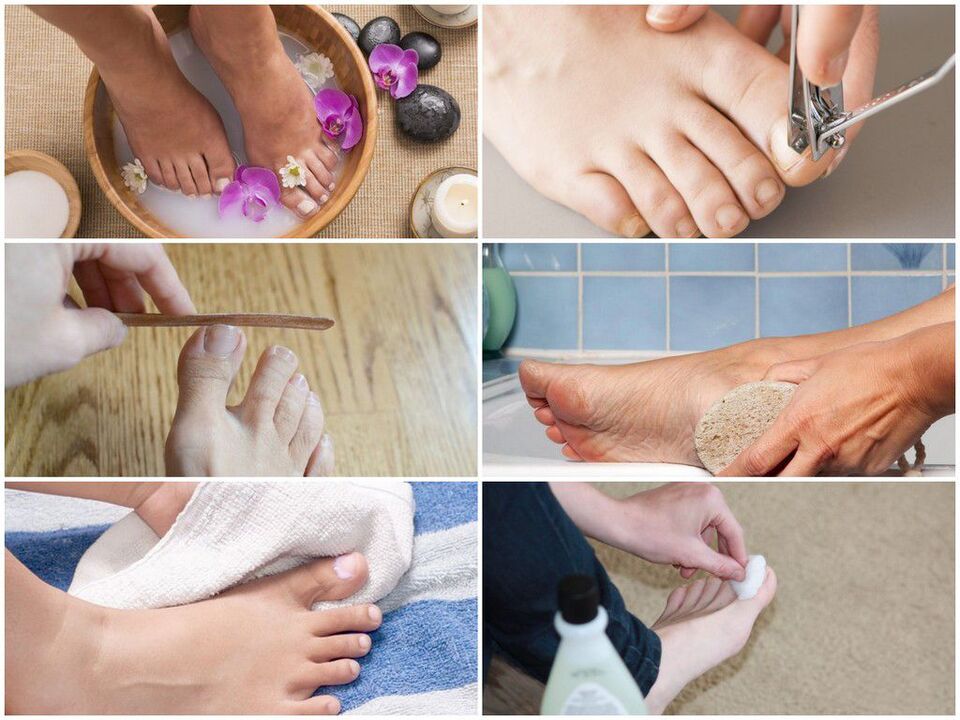
For preventionIt is necessary to comply with the rules of personal hygiene and reduce the possibility of re-infection:
- try to wear comfortable and high-quality shoes (to avoid excessive foot sweat);
- Socks and tights should be changed daily;
- Use personal shoes only. For people being treated for onychomycosis, shoes should be treated at the beginning of treatment, at least once a month for the entire duration of treatment, and upon completion;
- if necessary, use an antiperspirant for the feet;
- Use personal nail care kits (scissors, files);
- before and after visiting public places (swimming pools, bathhouses, gyms) using external antifungal agents (sprays, creams and pencils);
- Identify the source of fungal infection in the family and treat it simultaneously.
It is recommended to periodically carry out antifungal treatment of personal belongings, shoes, bathtubs, floors and carpets. For these purposes, you can use a 40% acetic acid solution, 1% chlorhexidine alcohol solution (as prescribed by your doctor) and antiseptic solutions. Linen can be boiled in a 1-2% soap-soda solution for 20-30 minutes, ironing at maximum temperature.

























